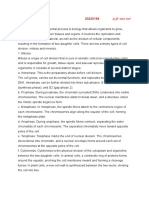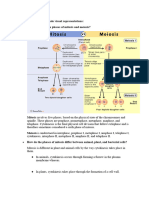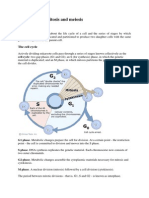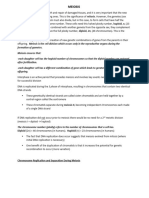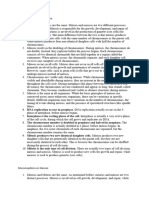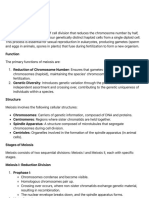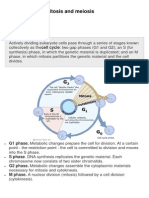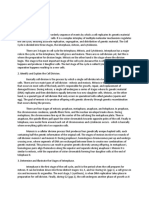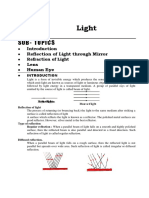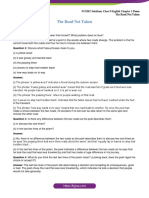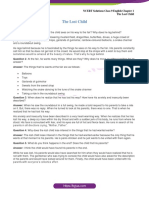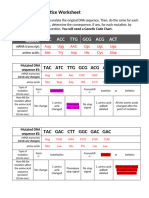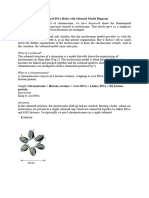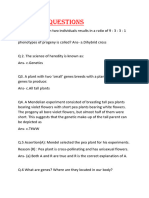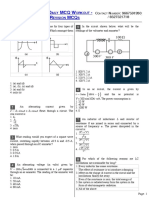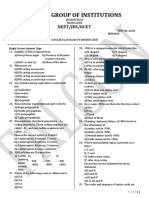Cell Division
Cell Division
Uploaded by
Manas AgrawalCopyright:
Available Formats
Cell Division
Cell Division
Uploaded by
Manas AgrawalCopyright
Available Formats
Share this document
Did you find this document useful?
Is this content inappropriate?
Copyright:
Available Formats
Cell Division
Cell Division
Uploaded by
Manas AgrawalCopyright:
Available Formats
Cell division is a fundamental biological process by which a single parent cell
divides into two or more daughter cells. It plays a crucial role in the growth,
development, and reproduction of organisms. There are two primary types of cell
division: mitosis and meiosis. Let's explore these processes in detail:
1. Mitosis:
Mitosis is a form of cell division that occurs in somatic (non-reproductive) cells
and is responsible for growth, repair, and asexual reproduction in some organisms.
It consists of several distinct phases:
- Interphase: This is the stage preceding mitosis, during which the cell grows,
carries out its normal functions, and replicates its DNA.
- Prophase: The chromatin condenses into visible chromosomes, and the nuclear
membrane disintegrates. The spindle apparatus, composed of microtubules, begins to
form.
- Metaphase: The chromosomes align along the equatorial plane of the cell. Each
chromosome is attached to the spindle fibers by its centromere.
- Anaphase: The sister chromatids separate and are pulled toward opposite poles of
the cell. The spindle fibers shorten, aiding in the movement of chromosomes.
- Telophase: The chromosomes reach the opposite poles of the cell, and nuclear
envelopes start to form around them. The chromatin expands, and the spindle
apparatus disassembles.
- Cytokinesis: The division of the cytoplasm occurs, resulting in the formation of
two daughter cells. In animal cells, a cleavage furrow forms, constricting the cell
membrane, while in plant cells, a cell plate forms to divide the cytoplasm.
Mitosis ensures that the genetic material is equally distributed between daughter
cells, resulting in genetically identical cells.
2. Meiosis:
Meiosis is a specialized form of cell division that occurs in reproductive cells
(gametes) to produce haploid cells with genetic diversity. It involves two
successive divisions: Meiosis I and Meiosis II. Each division consists of prophase,
metaphase, anaphase, telophase, and cytokinesis stages.
- Meiosis I: Homologous chromosomes pair up and exchange genetic material in a
process called crossing over during prophase I, increasing genetic diversity. In
metaphase I, homologous chromosome pairs align at the equatorial plane. During
anaphase I, homologous chromosomes separate and move to opposite poles. Telophase I
and cytokinesis follow, resulting in two haploid cells.
- Meiosis II: Similar to mitosis, the daughter cells from Meiosis I enter a second
division. Chromosomes align at the equatorial plane during metaphase II, and sister
chromatids separate during anaphase II, moving to opposite poles. Telophase II and
cytokinesis follow, resulting in the formation of four haploid daughter cells.
Meiosis generates genetic variation by shuffling and recombination of genetic
material, and it is essential for sexual reproduction.
Cell division is a tightly regulated process involving checkpoints that ensure
accurate DNA replication, repair of DNA damage, and proper segregation of
chromosomes. These mechanisms help maintain the integrity and stability of the
genetic material.
You might also like
- Mitosis Is A Process Where A Single Cell Divides Into Two Identical Daughter Cells (Cell Division)Document10 pagesMitosis Is A Process Where A Single Cell Divides Into Two Identical Daughter Cells (Cell Division)Holly Mc Kenzie Layson DalmanNo ratings yet
- Cytogenetics Mitosis & Meiosis and Their DiferrencesDocument11 pagesCytogenetics Mitosis & Meiosis and Their DiferrencesGeemilReyNo ratings yet
- Assignment Histology 1Document2 pagesAssignment Histology 1ahmadNo ratings yet
- Group H Pathology PresentationDocument15 pagesGroup H Pathology PresentationdorsukendraNo ratings yet
- Cell DivisionDocument8 pagesCell DivisionNusrat ShoshiNo ratings yet
- Cell DivisionDocument3 pagesCell DivisionIbukun OlaitanNo ratings yet
- The Cell CycleDocument3 pagesThe Cell CycleAngelooNo ratings yet
- Cell DivisionDocument5 pagesCell DivisionEloisa MadrilenoNo ratings yet
- 6b SamiDocument21 pages6b SamiluxxenNo ratings yet
- Class Notes Biology IIDocument143 pagesClass Notes Biology IIKarla CamposNo ratings yet
- cell_reproduction noteDocument1 pagecell_reproduction notefexoje2752No ratings yet
- Cell DivisionDocument27 pagesCell DivisionLavinia DonaldNo ratings yet
- Pre-Lab - Mitosis and MeiosisDocument12 pagesPre-Lab - Mitosis and MeiosisMaria Jose MartinezNo ratings yet
- Cell Division o-WPS OfficeDocument2 pagesCell Division o-WPS OfficeRusselleen MalimbogNo ratings yet
- Mitosis and MeiosisDocument21 pagesMitosis and MeiosisJuLie Ann DeGuzman Geslani100% (1)
- Mitosis Vs MeiosisDocument7 pagesMitosis Vs MeiosisJD DX100% (1)
- The Cell Cycle-TRFDocument8 pagesThe Cell Cycle-TRFmaniiiiiiiiNo ratings yet
- Mitosis Process ProjectDocument2 pagesMitosis Process Projectapi-242679288No ratings yet
- Charbel Matar BIO RESEARCHDocument5 pagesCharbel Matar BIO RESEARCH2eemmee eeccoolleeNo ratings yet
- 4.2 Cell As A Unit of LifeDocument7 pages4.2 Cell As A Unit of Lifehola adiosNo ratings yet
- What Is Mitosis & MeiosisDocument7 pagesWhat Is Mitosis & MeiosisMuhammad VaizNo ratings yet
- Mitosis and MeiosisDocument8 pagesMitosis and MeiosisShiela BelandresNo ratings yet
- Biology CH # 5 To 9 NoteDocument83 pagesBiology CH # 5 To 9 Notefurqanshaikh2334No ratings yet
- Science 8 Quarter 4 Shortened Module 2 CELL DIVISION Week 2Document6 pagesScience 8 Quarter 4 Shortened Module 2 CELL DIVISION Week 2Alvin OliverosNo ratings yet
- Mitosis and MeiosisDocument2 pagesMitosis and MeiosisFrances Isko FranciscoNo ratings yet
- Cell DivisionDocument38 pagesCell DivisionJane Marry IgnacioNo ratings yet
- Science8 Q4 M2Document6 pagesScience8 Q4 M2Arabella BaldonadoNo ratings yet
- CN 6 BioDocument2 pagesCN 6 BioJanna PaduaNo ratings yet
- Cell Cycle and Cell Division Class 11 Notes. " (Cbse)Document8 pagesCell Cycle and Cell Division Class 11 Notes. " (Cbse)madam photonNo ratings yet
- Week 2Document8 pagesWeek 2lilyrosemary.masilangNo ratings yet
- Reproduction and Cell DivisionDocument5 pagesReproduction and Cell Divisioneu.ashiya.pama2008No ratings yet
- Cell Structure and Cell DivisionDocument70 pagesCell Structure and Cell DivisionAMALIA INDAH ALLIZA ALLIZANo ratings yet
- Module 2 Cell DivisionDocument8 pagesModule 2 Cell DivisionGifted GuppyNo ratings yet
- Science Reviewer - Cell CycleDocument7 pagesScience Reviewer - Cell CycleCarlieseNo ratings yet
- Grade 8 Osmeña Q4 - Week 2Document48 pagesGrade 8 Osmeña Q4 - Week 2SHAIRA LYN CUMILANGNo ratings yet
- 4 MeiosisDocument5 pages4 MeiosisVarun GoseinNo ratings yet
- Misconceptions On Mitosis and MeiosisDocument2 pagesMisconceptions On Mitosis and MeiosisEdcademiaNo ratings yet
- Meiosis I & 2Document17 pagesMeiosis I & 2Mar Delos ReyesNo ratings yet
- Cell DivisionDocument12 pagesCell Divisiontaranashamdasani0509No ratings yet
- Differences Between Mitosis and MeiosisDocument79 pagesDifferences Between Mitosis and Meiosismaxwell amponsahNo ratings yet
- Gen-Bio-Anaclito-10-24-2024 - CADocument3 pagesGen-Bio-Anaclito-10-24-2024 - CAchristianrey.anaclitoNo ratings yet
- BiologyDocument2 pagesBiologywaniyaabbasi18No ratings yet
- The Cell CycleDocument9 pagesThe Cell Cyclesalahuddin_md5935No ratings yet
- Stages of MeiosisDocument7 pagesStages of MeiosisJustin BiboNo ratings yet
- MitosisDocument4 pagesMitosisJeanelle VillanuevaNo ratings yet
- Bio SciDocument3 pagesBio ScilowdicakesNo ratings yet
- New Microsoft Office Word DocumentDocument2 pagesNew Microsoft Office Word DocumentAngelo Gomez BadatoNo ratings yet
- Mitosis V MeiosisDocument5 pagesMitosis V MeiosisddaarrsshhiittNo ratings yet
- Cell DivisionDocument5 pagesCell DivisionLief LifeNo ratings yet
- CH 15 NotesDocument5 pagesCH 15 NotesCJNo ratings yet
- Mitosis DefinitionDocument19 pagesMitosis DefinitionMar Delos ReyesNo ratings yet
- Cell DivisionDocument2 pagesCell Divisionrobertsontrent25No ratings yet
- GEn. Bio Week 4 and Week 5Document3 pagesGEn. Bio Week 4 and Week 5VadePlaysCodNo ratings yet
- Science 8 Quarter 4 Shortened Module 2 CELL DIVISION Week 2Document6 pagesScience 8 Quarter 4 Shortened Module 2 CELL DIVISION Week 2Alvin OliverosNo ratings yet
- Eukaryotic CellsDocument6 pagesEukaryotic CellsbaneNo ratings yet
- Sci8_Q4_Wk2_Cell-Division_BagaoisanDocument15 pagesSci8_Q4_Wk2_Cell-Division_BagaoisanjannahcabotajeNo ratings yet
- Cell CycleDocument12 pagesCell CycleVega, Charles Gabriel G.No ratings yet
- 2.1.6 Biology Ocr ADocument7 pages2.1.6 Biology Ocr AFatima AfifiNo ratings yet
- A Simple Guide to the Blood Cells, Related Diseases And Use in Disease DiagnosisFrom EverandA Simple Guide to the Blood Cells, Related Diseases And Use in Disease DiagnosisNo ratings yet
- Adobe Scan 03-Nov-2023Document1 pageAdobe Scan 03-Nov-2023Manas AgrawalNo ratings yet
- 01 Kinematics 1-42Document42 pages01 Kinematics 1-42Manas AgrawalNo ratings yet
- 02 - Force and Lows of Motion - 43-66Document25 pages02 - Force and Lows of Motion - 43-66Manas AgrawalNo ratings yet
- 05 Light 20-52Document33 pages05 Light 20-52Manas AgrawalNo ratings yet
- Chapter-1 (The Story of Village Palampur)Document4 pagesChapter-1 (The Story of Village Palampur)Manas AgrawalNo ratings yet
- Chapter 1 (The Fun They Had)Document7 pagesChapter 1 (The Fun They Had)Manas AgrawalNo ratings yet
- Chapter 2 (Wind)Document1 pageChapter 2 (Wind)Manas AgrawalNo ratings yet
- Bhool Bhulaiya Title TrackDocument7 pagesBhool Bhulaiya Title TrackManas AgrawalNo ratings yet
- Chapter 1 (The Road Not Taken)Document2 pagesChapter 1 (The Road Not Taken)Manas AgrawalNo ratings yet
- Chapter-1 (The Lost Child)Document1 pageChapter-1 (The Lost Child)Manas AgrawalNo ratings yet
- Chapter-2 (The Adventure of Toto)Document1 pageChapter-2 (The Adventure of Toto)Manas AgrawalNo ratings yet
- 295 NotesDocument2 pages295 NotesManas AgrawalNo ratings yet
- Hsslive Xii Zoology Term 2 Dec 2022 Key DR Sunil KumarDocument3 pagesHsslive Xii Zoology Term 2 Dec 2022 Key DR Sunil Kumarandrewsbiju05No ratings yet
- Genetic Engineering - Selective Breeding 1 MSDocument11 pagesGenetic Engineering - Selective Breeding 1 MSMusyoka DanteNo ratings yet
- Universitas Muhammadiyah PalembangDocument15 pagesUniversitas Muhammadiyah PalembangMadie BackNo ratings yet
- Genetic EngineeringDocument10 pagesGenetic EngineeringJoshua BermoyNo ratings yet
- DNA Mutations Practice WorksheetDocument3 pagesDNA Mutations Practice Worksheetats.museNo ratings yet
- solenoid structureDocument3 pagessolenoid structureKashish GuptaNo ratings yet
- Science 9 Class NotesDocument1 pageScience 9 Class NotesTien NguyenNo ratings yet
- Building DNASEDocument3 pagesBuilding DNASEadhrit.mahatoNo ratings yet
- Daily Lesson LogDocument4 pagesDaily Lesson LogHazele Cruz - RiveraNo ratings yet
- Probability, Ratio of Genotype & Phenotype, Chi SquareDocument34 pagesProbability, Ratio of Genotype & Phenotype, Chi SquarekfaizahNo ratings yet
- Mutations ClassificationDocument25 pagesMutations ClassificationEdessa G. FlordelizNo ratings yet
- DNA Kinetics ReassociationDocument4 pagesDNA Kinetics ReassociationSarmistha NayakNo ratings yet
- A Deep Intronic Splice Mutation of STAT3 Underlies Hyper IgE Syndrome by Negative DominanceDocument10 pagesA Deep Intronic Splice Mutation of STAT3 Underlies Hyper IgE Syndrome by Negative DominanceWalid AissaNo ratings yet
- Examination Oriented: Name: Surname: School: Royal CollegeDocument232 pagesExamination Oriented: Name: Surname: School: Royal CollegeOwami MncubeNo ratings yet
- Biology QuestionsDocument4 pagesBiology Questions༒?MRxŇιlคʏʀǟռʝǟռ?༒No ratings yet
- Day 29 - Daily MCQ Workout - 40 Revision MCQsDocument5 pagesDay 29 - Daily MCQ Workout - 40 Revision MCQsnorah araujoNo ratings yet
- Cats GeneticsDocument1 pageCats GeneticsMaria Guadalupe AhujaNo ratings yet
- Maths Skills Question BookletDocument53 pagesMaths Skills Question BookletPrem PakirisamyNo ratings yet
- Resume - Leila JamaliDocument4 pagesResume - Leila Jamalimohammadrezahajian12191No ratings yet
- WEEK 4 Lessons 1 To 3 MITOSIS MEIOSISDocument59 pagesWEEK 4 Lessons 1 To 3 MITOSIS MEIOSISjanezpersonalzNo ratings yet
- Recent Research Paper On PCRDocument4 pagesRecent Research Paper On PCRgz8zw71w100% (1)
- Biotechnology: Principles and Processes - (DPP-01) : Lakshya (Neet)Document5 pagesBiotechnology: Principles and Processes - (DPP-01) : Lakshya (Neet)Ram MeharNo ratings yet
- Assignment Molecular-Cell-Biology-Applied-GeneticsDocument19 pagesAssignment Molecular-Cell-Biology-Applied-GeneticsRidma madusanka weerasinghaNo ratings yet
- Biotech Q4 Weke 5 6Document23 pagesBiotech Q4 Weke 5 6Arins Zae BajamundiNo ratings yet
- Bioinformatika Dan Aplikasi Pada Bidang KesehatanDocument20 pagesBioinformatika Dan Aplikasi Pada Bidang Kesehataneka sukmawatidewiNo ratings yet
- Faculty of Biotechnology: Molecular Genetics and Genetic Engineering GEN301Document9 pagesFaculty of Biotechnology: Molecular Genetics and Genetic Engineering GEN301mariam farragNo ratings yet
- 15.1 To 15.3 BiologyDocument11 pages15.1 To 15.3 Biologyminda.eslteacherNo ratings yet
- CYTOGENETICS Worksheet 2Document4 pagesCYTOGENETICS Worksheet 2ST12A3- Pulvera, James McleanNo ratings yet
- Principle of Inheritance and VariationDocument11 pagesPrinciple of Inheritance and VariationDikansha JasaiwalNo ratings yet
- Mysore Bio 30 NovDocument7 pagesMysore Bio 30 NovAbdus SamadNo ratings yet


